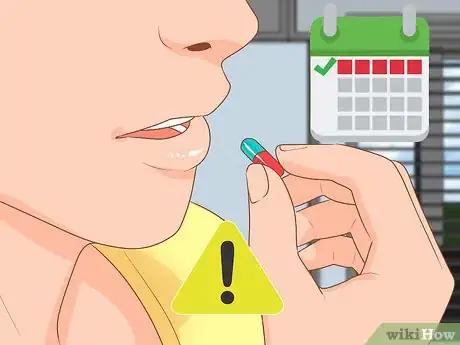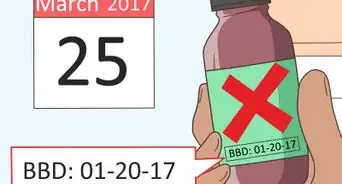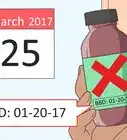This article was medically reviewed by Luba Lee, FNP-BC, MS. Luba Lee, FNP-BC is a Board-Certified Family Nurse Practitioner (FNP) and educator in Tennessee with over a decade of clinical experience. Luba has certifications in Pediatric Advanced Life Support (PALS), Emergency Medicine, Advanced Cardiac Life Support (ACLS), Team Building, and Critical Care Nursing. She received her Master of Science in Nursing (MSN) from the University of Tennessee in 2006.
There are 15 references cited in this article, which can be found at the bottom of the page.
This article has been viewed 58,075 times.
No one likes being irregular when it comes to bowel movements, so if you're having issues, Metamucil fiber may help. It's a fiber supplement that contains psyllium husk, and its purpose is to help regulate your stomach issues, whether you're having constipation or diarrhea. Typically, the medication comes in a powder form, which you mix with water, or a capsule form, which you should drink with water.
Steps
Taking Metamucil Powder
-
1Add 1 rounded teaspoon (6 g) to a glass for an adult dose. "Rounded" means you don't level the teaspoon across the top. For children between 6-12, cut the dose in half, adding 1/2 of a rounded teaspoon (about 3 grams) to the glass.[1] Use this dose for the original coarse powder.
- Consult with a doctor before giving children under 6 a dose of Metamucil.
- Don't try to take the powder dry, as it could make you choke. Plus, it will be pretty unpleasant to swallow!
- Always read the package before measuring out a dose, as the dosage can vary based on what kind you have.
- For the smooth powder, use 1 rounded tablespoon (about 18 grams) for digestive problems. If you're using the smooth powder as an appetite suppressant before meals, you can use 2 rounded tablespoons (about 36 grams).
-
2Pour in at least 8 fluid ounces (240 mL) of water or another liquid. Pour in the same amount of water whether you have an adult dose or child dose, including the double adult doses. You can add extra water if you'd like, especially if it is too thick. Stir the solution to mix in the powder.[2]
- You can mix in juice if you like it better.
- Avoid using hot liquids! Always use cool or room temperature beverages.
Advertisement -
3Drink all of the liquid in the glass at once. To make sure you are getting the full dose, down the whole glass! If you leave anything in the glass, you're likely leaving some of the medication behind, too.[3]
- Plus, if you let it sit around, it can thicken up, which isn't very nice to drink!
-
4Consume up to 3 doses a day. Start off with 1 dose daily, and gradually increase your dosage if you need to. If a single dose a day proves helpful, you can stick to that. Otherwise, you can take this medication up to 3 times in a day if you decide you need the extra help to treat your constipation or diarrhea.[4]
- Taking it at mealtimes may help you remember.
Taking Metamucil Capsules
-
1Count out 5 capsules for an adult dose. These capsules contain the same medication as the powder. The powder is just stuffed into the capsules to make it easier to swallow if you prefer pills.[5]
- For a child under 12, ask your doctor for an appropriate dose.
-
2Swallow a single capsule at a time, followed with water. Drink a little bit of water to wet your mouth and then put the capsule on your tongue. Take a large gulp of water and swallow it and the capsule at the same time.[6]
- Take the capsules individually.
-
3Make sure to drink at least 8 fluid ounces (240 mL) of water or liquid with a 5 capsule dose. Even with the medication in capsule form, you need to drink plenty of water to help it go down. You don't need to measure it out as long as you gulp down a medium-to-large glass of water.[7]
- Taking the capsules dry can be a choking hazard.
- The medication's job is to absorb liquid in the intestines, making it easier to have a bowel movement by collecting the food in your stomach together. However, if you don't have enough liquid in your stomach, it can cause constipation.[8]
-
4Take a dose up to 3 times a day. You can just take 1 dose a day if that's enough to help treat your diarrhea or constipation. You can increase the frequency to 3 times a day if you need to.[9]
- Try taking it in the morning, at noon, and at bedtime. Alternatively, try taking it at mealtimes to help you remember.
Making Metamucil More Effective
-
1Use Metamucil when you first notice a stomach issue. Whether it's constipation or diarrhea, try taking a dose right away. By dosing as soon as you notice symptoms, you'll get relief that much quicker.[10]
- The medication generally begins working between 12 and 72 hours after you take it.
-
2Avoid taking Metamucil for longer than 1 week unless directed. If you are having constipation or diarrhea issues lasting more than a week, you should discuss those issues with your doctor. However, for chronic issues, your doctor may suggest you take this medication every day for extended periods.[11]
-
3Drink extra water to help prevent constipation. This medication can stop you up if you are having diarrhea, but it can go too far the other way, which is equally unpleasant. If you drink plenty of water, including an extra glass or 2 more than you normally do, that can help alleviate this issue.[12]
- Aim for 15.5 cups (3.7 L) of water per day if you're a man and 11.5 cups (2.7 L) per day if you're a woman.[13]
-
4Talk to your doctor to make sure Metamucil is right for you. This medication can affect the absorption of other medicines, so it's always best to talk to your doctor. Also, if you have conditions like high blood pressure, heart disease, bleeding from your anus, intestinal issues, kidney conditions, or diabetes mellitus, talk to your doctor first, as this may not be the right medication for you.[14]
- Similarly, while this medication is generally considered safe during pregnancy, you should always talk to your doctor before starting it.[15]
-
5Leave a 2-hour space between Metamucil and other medications. This medication can affect how other prescription drugs are absorbed. Therefore, it's best to wait 2 hours before or after other medications when taking this one.[16]
- For certain medications, such as salicylates (aspirin), digoxin (Lanoxin), and nitrofurantoin (Furadantin, Macrobid, Macrodantin), you should wait 3 hours between taking them and taking Metamucil.
-
6Seek medical care if you have difficulty breathing or stomach pain. You may also notice vomiting, itching, problems swallowing, and nausea. A skin rash may appear if you are having an allergic reaction to the medication.[17]
- If you are having trouble breathing or swallowing, go to the emergency room. Otherwise, you can likely call your doctor or go to urgent care, unless the pain is severe.
Warnings
- Check the expiration date before using; throw it out if it's past the expiration.⧼thumbs_response⧽
- Metamucil can give you gas. When first starting out, try 1 dose a day to help prevent this issue.⧼thumbs_response⧽
- Make sure you don’t have any allergic reactions to Metamucil before taking large doses of it.⧼thumbs_response⧽
References
- ↑ https://dailymed.nlm.nih.gov/dailymed/drugInfo.cfm?setid=a9824f73-5ea2-4a65-a926-3a57561441b8
- ↑ https://stewartmedicine.com/patient-education/patient-education-2/metamucil-psyllium-fiber/
- ↑ https://dailymed.nlm.nih.gov/dailymed/drugInfo.cfm?setid=a9824f73-5ea2-4a65-a926-3a57561441b8
- ↑ https://medlineplus.gov/druginfo/meds/a601104.html
- ↑ https://dailymed.nlm.nih.gov/dailymed/drugInfo.cfm?setid=93f5baf1-f7c3-4e9c-ae90-cb470e3a1c51
- ↑ https://stewartmedicine.com/patient-education/patient-education-2/metamucil-psyllium-fiber/
- ↑ https://patient.info/medicine/psyllium-husk-for-constipation-equate-konsyl-metamucil-reguloid
- ↑ https://www.drugs.com/cdi/metamucil-psyllium-powder.html
- ↑ https://medlineplus.gov/druginfo/meds/a601104.html
- ↑ https://dailymed.nlm.nih.gov/dailymed/drugInfo.cfm?setid=93f5baf1-f7c3-4e9c-ae90-cb470e3a1c51
- ↑ https://medlineplus.gov/druginfo/meds/a601104.html
- ↑ https://www.mayoclinic.org/healthy-lifestyle/nutrition-and-healthy-eating/expert-answers/fiber-supplements/faq-20058513
- ↑ https://www.mayoclinic.org/healthy-lifestyle/nutrition-and-healthy-eating/in-depth/water/art-20044256
- ↑ https://www.drugs.com/cdi/metamucil-psyllium-powder.html
- ↑ https://americanpregnancy.org/pregnancy-health/constipation-during-pregnancy/
- ↑ https://www.drugs.com/cdi/metamucil-psyllium-powder.html
- ↑ https://medlineplus.gov/druginfo/meds/a601104.html









































































Medical Disclaimer
The content of this article is not intended to be a substitute for professional medical advice, examination, diagnosis, or treatment. You should always contact your doctor or other qualified healthcare professional before starting, changing, or stopping any kind of health treatment.
Read More...